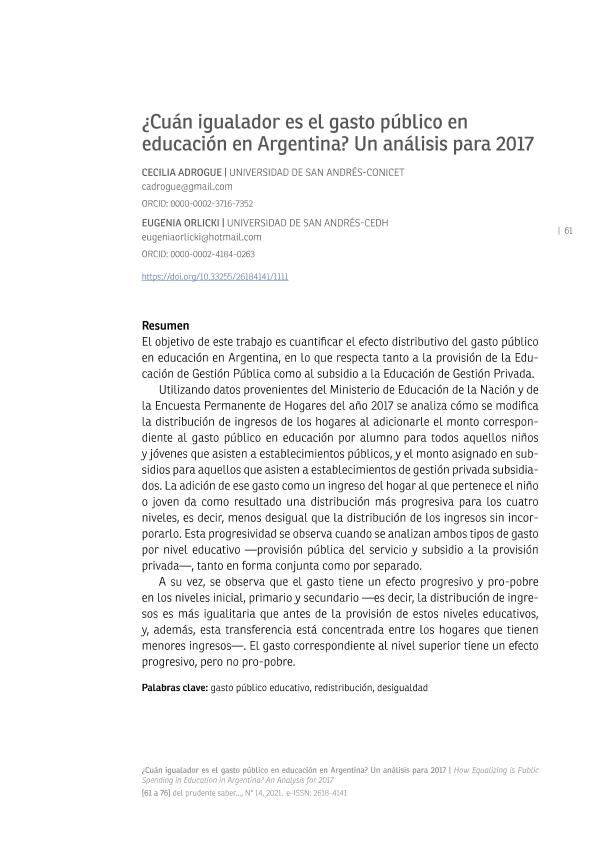Mostrar el registro sencillo del ítem
dc.contributor.author
Adrogué, Cecilia

dc.contributor.author
Orlicki, María Eugenia

dc.date.available
2022-02-22T15:51:11Z
dc.date.issued
2021-12
dc.identifier.citation
Adrogué, Cecilia; Orlicki, María Eugenia; ¿Cuán igualador es el gasto público en educación en Argentina? Un análisis para 2017; Universidad Nacional de Entre Ríos. Facultad de Ciencias de la Educación; Del prudente saber y el máximo posible de sabor; 23; 14; 12-2021; 61-76
dc.identifier.issn
1515-3576
dc.identifier.uri
http://hdl.handle.net/11336/152476
dc.description.abstract
El objetivo de este trabajo es cuantificar el efecto distributivo del gasto público en Educación en Argentina, en lo que respecta tanto a la provisión de la Educación de Gestión Pública como al subsidio a la Educación de Gestión Privada. Utilizando datos de la Encuesta Permanente de Hogares del año 2017 se analiza cómo se modifica la distribución de ingresos de los hogares al adicionarle el gasto público que reciben los niños y jóvenes en el ámbito público, y el monto asignado en subsidios para aquellos que asisten a establecimientos de gestión privada subsidiados. La aplicación de ese gasto da como resultado una distribución menos desigual que la de los ingresos sin incorporarlo, es decir, que es progresivo para los cuatro niveles. Esta progresividad se observa cuando se analizan ambos tipos de gasto por nivel educativo, tanto en forma conjunta como por separado. A su vez, se observa que aquel referido a los niveles inicial, primario y secundario público tiene un efecto progresivo y pro-pobre, mientras que el nivel superior tiene un efecto progresivo pero no pro-pobre.
dc.description.abstract
The aim of this article is to quantify the distributive effect of public spending on education in Argentina, with regard to both the provision of public education and the subsidy for private education. Using data from the National Ministry of Education and the Permanent Household Survey of 2017, it is analyzed how the distribution of household income is modified by adding the amount corresponding to the public spending on education per student that children and youths who attend public institutions receive in the public sphere, and the amount allocated in subsidies for those who attend subsidized privately run establishments. The application of this expenditure results in a more progressive distribution in the four levels, that is to say, a less unequal distribution than that of incomes without its incorporation. This progressivity is observed when both types of spending are analyzed by educational level —public provision of the service and subsidy to private provision—, both jointly and separately. In turn, it is observed that the expenditure on the initial, primary and secondary public levels has a progressive and pro-poor effect —that is, the income distribution is more egalitarian than before the provision of these educational levels and, furthermore, this transfer is concentrated among households with lower incomes—, while expenditure on public higher education has a progressive, but not pro-poor, effect.
dc.format
application/pdf
dc.language.iso
spa
dc.publisher
Universidad Nacional de Entre Ríos. Facultad de Ciencias de la Educación
dc.rights
info:eu-repo/semantics/openAccess
dc.rights.uri
https://creativecommons.org/licenses/by-nc-sa/2.5/ar/
dc.subject
GASTO PÚBLICO EDUCATIVO
dc.subject
REDISTRIBUCIÓN
dc.subject
DESIGUALDAD
dc.subject.classification
Otras Economía y Negocios

dc.subject.classification
Economía y Negocios

dc.subject.classification
CIENCIAS SOCIALES

dc.title
¿Cuán igualador es el gasto público en educación en Argentina? Un análisis para 2017
dc.title
How Equalizing is Public Spending in Education in Argentina? An Analysis for 2017
dc.type
info:eu-repo/semantics/article
dc.type
info:ar-repo/semantics/artículo
dc.type
info:eu-repo/semantics/publishedVersion
dc.date.updated
2022-01-25T15:00:14Z
dc.identifier.eissn
2618-4141
dc.journal.volume
23
dc.journal.number
14
dc.journal.pagination
61-76
dc.journal.pais
Argentina

dc.journal.ciudad
Paraná
dc.description.fil
Fil: Adrogué, Cecilia. Consejo Nacional de Investigaciones Científicas y Técnicas; Argentina. Universidad de San Andrés; Argentina
dc.description.fil
Fil: Orlicki, María Eugenia. Consejo Nacional de Investigaciones Científicas y Técnicas; Argentina. Universidad de San Andrés; Argentina
dc.journal.title
Del prudente saber y el máximo posible de sabor
dc.relation.alternativeid
info:eu-repo/semantics/altIdentifier/url/https://pcient.uner.edu.ar/index.php/dps/article/view/1111
dc.relation.alternativeid
info:eu-repo/semantics/altIdentifier/doi/http://dx.doi.org/10.33255/26184141/1111
Archivos asociados
